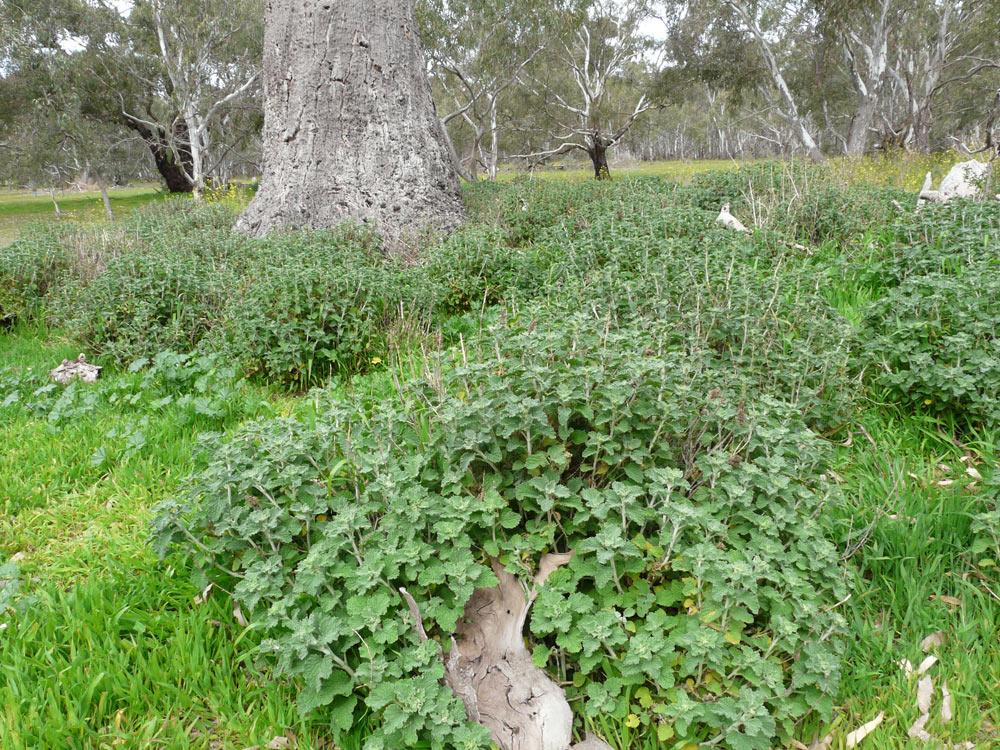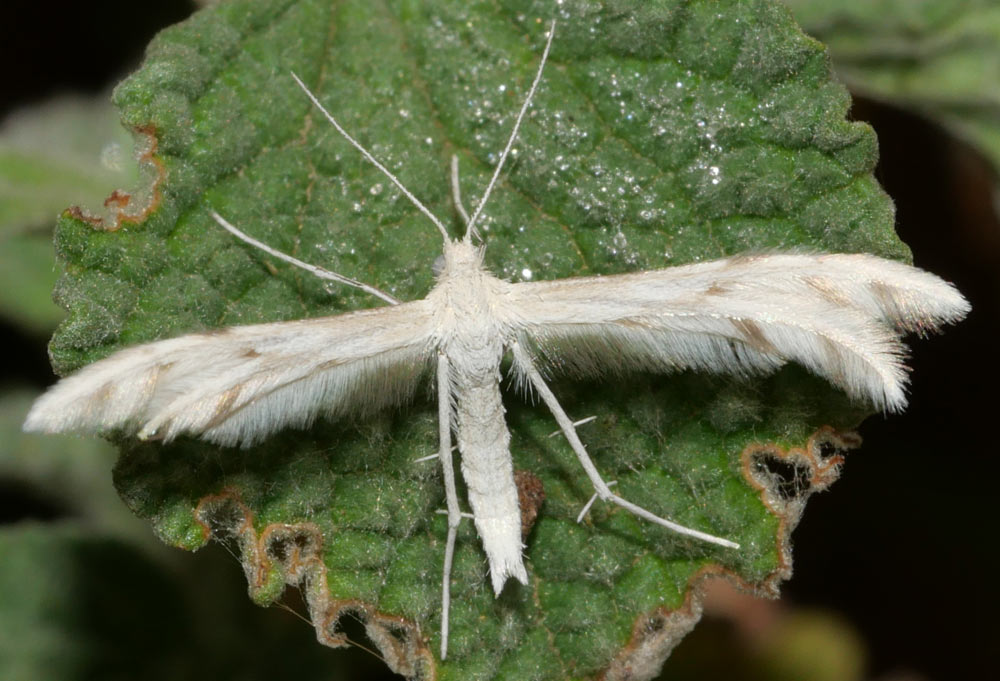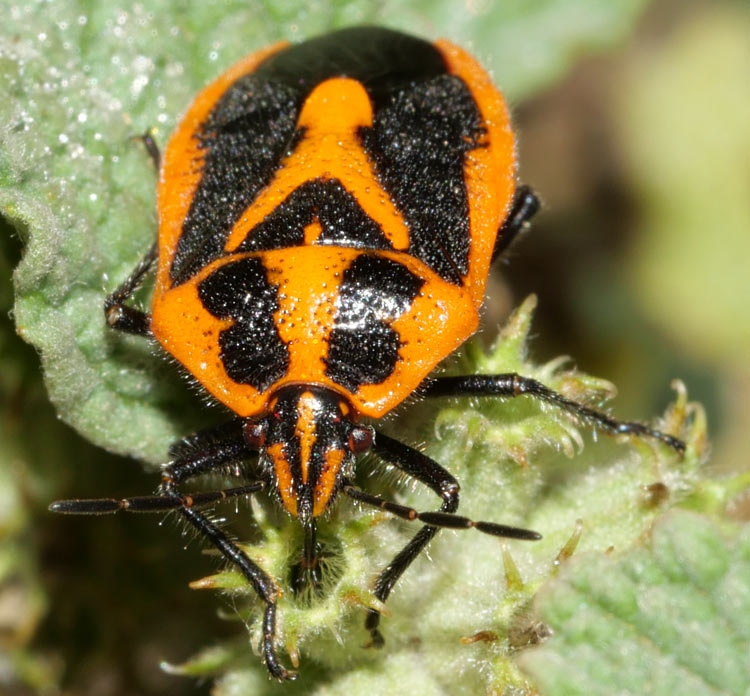Horehound is widespread in the park, mainly as small groups of plants under mature Red Gums. There are at least four larger patches, two under Red Gums and two on old rubbish tips. These patches have been there for many years and have not increased in size apart from one of the rubbish tip patches which has spread somewhat after invasive grass was killed adjacent to the patch. Given the lack of spread in less disturbed areas even under the current heavy Kangaroo grazing, Horehound cannot be considered a high priority weed in Woodlands Historic Park.

Biological Control
| Common Name | Scientific Name | Released | Effectiveness Nationally | Feeding Mode |
|---|---|---|---|---|
| Horehound Plume Moth | Wheeleria spilodactylus | 1994 | significant impact | eats shoots and leaves |
| Horehound Clear-wing Moth | Chamaesphecia mysiniformis | 1997 | Found in 50% of plants at some arid zone release sites, but the impact on plant populations not assessed | eats roots and stems |
The Horehound Clear-wing Moth was observed by Tom Morley at Woodlands Historic Park in 2012 and recorded in the Weed Biological Control database at http://root.ala.org.au/bdrs-core/wbiocont/home.htm. Unfortunately this database seems to have disappeared. Despite the fact that it appeared to be a part of the Atlas of Living Australia, there are no records of this moth in ALA and in fact the species is not even in the database, nor in the Australian Faunal Directory.
The Plume Moth is present in the park but seems to be very uncommon. Two large patches of Horehound in Twin Dams paddock were examined on 21st February 2021 and a total of only 10 pupae were found on 3 plants. (It is possible the winter generation are more numerous.)


A native insect Agonoscelis rutila is often seen in such large numbers on Horehound (including in the park) that it is universally known as the Horehound Bug. In fact the original native host for the insect is unknown, although assumed to be a plant in the same family.
Both nymph and adults Horehound Bugs feed primarily on ripe seed, although they also need to feed on green parts of the plant. Garms (2014, page 184) found that nymphs consume an average of at least 70 horehound seeds before reaching maturity, while adults consume 1-3 seeds per day and are capable of living for at least 150 days. He went on to estimate that under ideal conditions a single adult female could produce enough offspring to consume all the seed produced in a year by between 4 and 16 adult horehound plants.
In practice, the bug population, while it can be quite high on individual plants, does not reach sufficient levels overall to prevent spread of the the plant. Garms found that predation of nymphs and adults is negligible, while Loch and Walter (1999) found that predation of eggs is also negligable. This raises the question of why the bug population does not increase until they fully utilize the available food resource. The most likely answer seems to be a wasp, Trissolcus basalis, an egg parasitoid introduced multiple times into Australia to control the Green Vegetable Bug (Nezara viridula), beginning in 1933. Loch and Walter found 64% of Horehound Bug egg masses affected by this wasp, a higher rate than for the target Green Vegetable Bug. So it appears that an insect introduced to control a pest insect may be preventing control of a pest plant. The wasp also affects at least 25 other native bug species (references but not all species listed in Loch and Walter), including some predatory species beneficial to crops.
Another native insect, the Harlequin Bug, has been seen in Woodlands Historic Park feeding on Horehound flowers, but this bug is known to feed on many other plants as well.
References
- Garms, B. (2014) Native Insects as a Framework for Understanding Potential Impacts of Exotic Species. Thesis Ph.D., Australian National University, Canberra.
- Ireson John (2008) BIOLOGICAL CONTROL OF HOREHOUND: HOREHOUND PLUME MOTH. Tasmanian Institute of Agriculture: New Town.
- Ivory Susan (2012) The establishment of the clearwing moth for horehound control in South Australia. 18th Australasian weeds conference, ed. Valerie Eldershaw, pp. 541-4, Weed Society of Victoria Inc.
- Loch AD & Walter GH (1999) Multiple host use by the egg parasitoid Trissolcus basalis (Wollaston) in a soybean agricultural system: biological control and environmental implications. Agricultural and Forest Entomology 1: 271-280.
- Weiss J, Ainsworth N and Faithfull I (2000) Best practice management guide: Horehound, Marrubium vulgare. CRC for Weed Management Systems, University of Adelaide.
- Weiss John, Emma Wills, John Stoner, Ian Faithfull and Nicole Freeman (1998) Landcare note 162 - Horehound Suppression with the Horehound Clearwing Moth. Frankston: Keith Turnbull Research Institute.
- Weiss John and Jean-Louis Sagliocco (2012) Marrubium vulgare L. - horehound, in "Biological Control of Weeds in Australia", Jim Cullen, Mic Julien & Rachel McFadyen (editors). CSIRO Publishing.